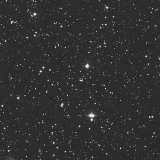
BG Geminorum
Encyclopedia
BG Geminorum is long period
eclipsing binary star system which contains a K0 I secondary star in orbit around a primary star. The primary star has a mass at least 3.5 times that of the sun
and could either be a B star (see Stellar Classification) or a black hole
. Material from the K0 star is transferred to an accretion disk surrounding the unidentified primary star.
star candidate with an uncertain period of ~ 60 days and a photographic magnitude
of ~ 14. Until 1992, BG Gem remained in the General Catalog of Variable Stars (GCVS), when Benson et al. (2000) discovered an ellipsoidal variation with an optical magnitude of about 0.5, and improved the accuracy of the period to 91.645 days. Using light curves, a deep primary eclipse was revealed at shorter wavelengths (less than 4400Å), and a shallow eclipse at longer wavelengths.
Orbital period
The orbital period is the time taken for a given object to make one complete orbit about another object.When mentioned without further qualification in astronomy this refers to the sidereal period of an astronomical object, which is calculated with respect to the stars.There are several kinds of...
eclipsing binary star system which contains a K0 I secondary star in orbit around a primary star. The primary star has a mass at least 3.5 times that of the sun
Sun
The Sun is the star at the center of the Solar System. It is almost perfectly spherical and consists of hot plasma interwoven with magnetic fields...
and could either be a B star (see Stellar Classification) or a black hole
Black hole
A black hole is a region of spacetime from which nothing, not even light, can escape. The theory of general relativity predicts that a sufficiently compact mass will deform spacetime to form a black hole. Around a black hole there is a mathematically defined surface called an event horizon that...
. Material from the K0 star is transferred to an accretion disk surrounding the unidentified primary star.
History
BG Gem was first observed by Hoffmeister (1933) and Jensch (1938) - initially an RV TauRV Tauri variable
RV Tauri variables are supergiant variable stars. They exhibit changes in luminosity which are tied to radial pulsations of their surfaces. Their changes in brightness are also correlated with changes in their spectral type. While at their brightest, the stars have spectral types F or G. At...
star candidate with an uncertain period of ~ 60 days and a photographic magnitude
Photographic magnitude
Before the advent of photometers which accurately measure the brightness of astronomical objects, the apparent magnitude of an object was obtained by taking a picture of it with a camera. These images, made on photoemulsive film or plates, were more sensitive to the blue end of the visual spectrum...
of ~ 14. Until 1992, BG Gem remained in the General Catalog of Variable Stars (GCVS), when Benson et al. (2000) discovered an ellipsoidal variation with an optical magnitude of about 0.5, and improved the accuracy of the period to 91.645 days. Using light curves, a deep primary eclipse was revealed at shorter wavelengths (less than 4400Å), and a shallow eclipse at longer wavelengths.

